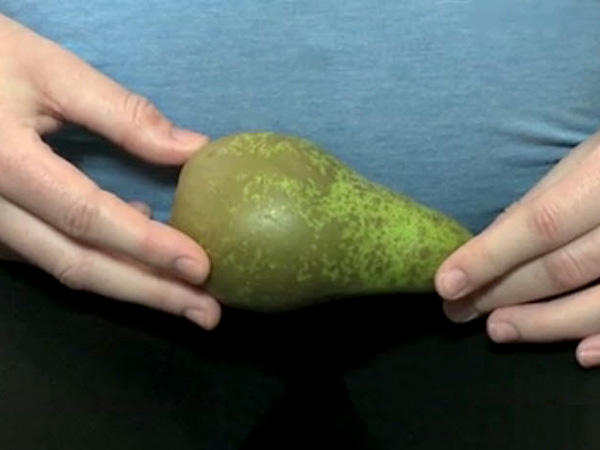Pregnancy
How to help your baby be born: video
Daphne Metland explains how a child's ball can help you to understand the most intense stage of labour. Daphne taught antenatal classes for the NCT for over 20 years, so she has prepared hundreds of couples for the birth of their baby. She was launch editor of BabyCentre.co.uk and is co-author of the bestselling book, Expecting.
Show transcript
Hide transcript
Daphne [holding model of pelvis]: Emily, let's talk about positions for labour and birth. For the last hundred years or so, women have been tucked up in bed in labour, and that's the worst position to be in, because the baby is actually pressing on your spine and on your sacroiliac joint.
[Daphne shows a small beach ball and a model of a human pelvis]
[Daphne holds beach ball between her thumb and forefinger]
This ball is 10cm in diameter, which is the size of the average baby's head. And you can see that it only just fits through the pelvis [passes ball through model of pelvis]. If you can be upright and mobile and make a lot more space in that pelvis, it will be easier for the baby to fit through. The weight of the baby and the size of the baby help dilate the cervix.
[Emily nods in agreement]
DM: If you are mobile, labour is shorter and contractions are more effective. And they're less painful. So it's well worth doing. So walk around, change position, kneel, do whatever makes you feel comfortable, listen to what your body's telling you and it will actually help labour progress.
And then, when you get to the second stage of labour, which is where you push your baby out, your position is really important. If you're lying flat on your back, imagine that this is the baby's head [taps ball against model of pelvis, which is tilted backwards at an angle], you'd be at this sort of angle on the hospital bed. Just try pushing that ball through the pelvis.
[Emily pushes the ball, which moves slowly through the model of the pelvis]
It's quite a struggle to get the ball through, isn't it? But see what happens if you stand up or you kneel, or squat? [Daphne holds the model of the pelvis in an upright position] So you're in a much more upright position? Now push the ball through the pelvis and we'll see what happens.
[Emily pushes ball through the upright model of the pelvis and the ball drops through easily]
So there's a big difference in the amount of space the baby's got to get through, if we compare lying down and being upright.
[Emily nods in agreement]
This joint has moved [touches sacroiliac joint] and the coccyx has moved out of the way [touches tailbone], and we've got a lot more space to get your baby through. It will be easier for you and your baby.
Sitting, kneeling or, if you're using a birth pool, squatting, can give you up to a third more space. So it's worth thinking about your position when you're thinking about labour and birth.
[Daphne shows a small beach ball and a model of a human pelvis]
[Daphne holds beach ball between her thumb and forefinger]
This ball is 10cm in diameter, which is the size of the average baby's head. And you can see that it only just fits through the pelvis [passes ball through model of pelvis]. If you can be upright and mobile and make a lot more space in that pelvis, it will be easier for the baby to fit through. The weight of the baby and the size of the baby help dilate the cervix.
[Emily nods in agreement]
DM: If you are mobile, labour is shorter and contractions are more effective. And they're less painful. So it's well worth doing. So walk around, change position, kneel, do whatever makes you feel comfortable, listen to what your body's telling you and it will actually help labour progress.
And then, when you get to the second stage of labour, which is where you push your baby out, your position is really important. If you're lying flat on your back, imagine that this is the baby's head [taps ball against model of pelvis, which is tilted backwards at an angle], you'd be at this sort of angle on the hospital bed. Just try pushing that ball through the pelvis.
[Emily pushes the ball, which moves slowly through the model of the pelvis]
It's quite a struggle to get the ball through, isn't it? But see what happens if you stand up or you kneel, or squat? [Daphne holds the model of the pelvis in an upright position] So you're in a much more upright position? Now push the ball through the pelvis and we'll see what happens.
[Emily pushes ball through the upright model of the pelvis and the ball drops through easily]
So there's a big difference in the amount of space the baby's got to get through, if we compare lying down and being upright.
[Emily nods in agreement]
This joint has moved [touches sacroiliac joint] and the coccyx has moved out of the way [touches tailbone], and we've got a lot more space to get your baby through. It will be easier for you and your baby.
Sitting, kneeling or, if you're using a birth pool, squatting, can give you up to a third more space. So it's worth thinking about your position when you're thinking about labour and birth.
Track your baby’s development

Join now to receive free weekly newsletters tracking your baby’s development and yours throughout your pregnancy.
By registering you agree to our Terms of Use & Privacy policy. We use your information to send you emails, product samples, and promotions on this website and other properties. We use your health information to make our site even more helpful.
Advertisement
- Community
-
Getting pregnant
TOP RESOURCES
-
Pregnancy
TOP RESOURCES
-
Baby
TOP RESOURCES
-
Toddler
TOP RESOURCES
-
Life as a parent
TOP RESOURCES
-
हिंदी
TOP RESOURCES
-
Regional languages
TOP RESOURCESPOPULAR TOPICS
-
Video
TOP VIDEOS











